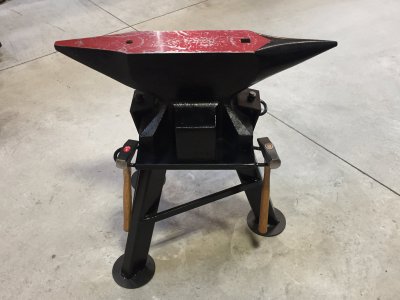From the advertising, it appears the the cast steel anvils have been hardened which will help to prevent denting from cold iron or hammer blows. A better option is a forged steel anvil as it tends to align and refine the grain structure of the steel. It seems that some of the higher priced anvils specifically use 4140 steel, hardened to between 48 and 62 Rc. Vervor just states that they use premium steel.They do say it is heat treated which implies some carbon.
I'll admit up front that I'm an anvil nerd...I've owned over 100 of them from almost every major vintage brand as well as a handful of modern production anvils.
As with anything there really isn't a blanket statement that covers this topic accurately. The very best anvils made today are made by Refflinghaus in Germany. I have two of them...330lbs and 325lbs and both are just a few years old. They are cast steel and hardened to a degree and depth most people wouldn't believe. Refflinghaus originally made forged steel anvils, but switched to cast steel with a forged welded top in 1958 and then all cast steel in 1975 and the quality is as good, or better than ever. They claim the current design is the best ever. They carbon soak them in a forge for an extended period before quenching and they claim that the surface hardness is a full 1" deep and minimum Rockwell 59, so quite hard. There is a wait list to get them and the prices are intimidating....the two I have are over $4K each now. I have used forged steel anvils made in German and France that were fantastic, but no better than the Refflinghaus.
Similarly, most Swedish anvils like Soderfors and Kohlswa are cast steel and as good as any forged steel anvil. In fact, Soderfors (still have two of those) are known to be on the edge of being too hard. There were also a number of American cast steel anvils that were extremely high quality and I'd put them as right there with the best forged steel anvils...Columbian, West, and Vanadium Steel brands were all fantastic.
Most modern cast steel anvils aren't made to quite that standard because the steel required is fairly specialized and too expensive to source in the volume needed for anvil production now (very limited). The Holland brand anvil made in Michigan uses H13 and the family making them appears to be tagging anvil production on to the end of production for something related to the car industry and that allows them to use a specialized steel that would otherwise be cost-prohibitive (see $4K anvils above).
I guess that's a long way of saying that with the right materials and knowledge, it's possible to make a cast steel anvil that is as good as any other method, and possibly better. Obviously that doesn't cover HF or Vevor, but I don't think that's a surprise to anybody.
Traditionally, the horn of the anvil was soft, which is why so many old anvils have mushroomed horns.
I think it depends on how far back you look. Quite a few anvil brands used tool/alloy steel horns that were hardened. The typical wrought iron body anvils like most English anvils and probably half of the American brands used a soft wrought iron horn, but quite a few used a steel horn that was hardened. Most of the time when you see the tip of the horn mushroomed it was done intentionally so they wouldn't poke themselves on it.



